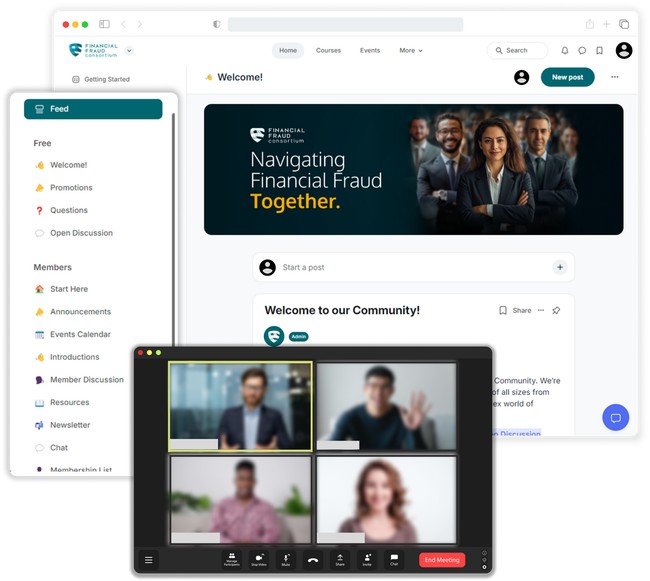Recent Posts

Ransomware attacks, a form of cyberattack that’s become all too common in recent years, pose a significant threat to the financial sector, locking institutions out of their systems and demanding hefty ransoms to restore access. Not only do these cyberattacks disrupt operations, but they also threaten customer confidence and data security. In continuation of our August monthly theme on the discussion on advanced and effective strategies that can strengthen the cyber defenses of financial institutions, we will focus this blog topic on preventive strategies that can shield financial institutions from such debilitating threats. Understanding Ransomware Threats Ransomware is a type of malware that encrypts an institution’s data, making it inaccessible until a ransom is paid. Fraudsters typically infiltrate systems through phishing emails, compromised credentials, or unpatched software vulnerabilities. The repercussions of these attacks can be extensive, affecting not just the targeted institution but also the broader financial network. Beyond immediate financial loss, ransomware attacks disrupt services, damage customer relationships, and can result in severe regulatory penalties if sensitive data is exposed. Institutions must therefore recognize ransomware not just as a potential IT inconvenience but as a critical threat to operational continuity and customer trust. Adopting a Proactive Security Posture Preventing ransomware starts with taking a proactive security posture. Financial institutions should conduct regular vulnerability assessments and patch management to close any gaps that could be exploited by attackers. Advanced endpoint protection solutions can detect and neutralize ransomware payloads before they execute, providing an essential layer of defense. Additionally, employing network segmentation can limit the spread of ransomware if it does penetrate the first layers of defense. By isolating critical network segments from one another, institutions can prevent an attack on one part from incapacitating the entire network, thus safeguarding vital operations and data. Implementing Robust Backup and Recovery Plans A robust data backup and recovery plan is critical in the fight against ransomware. Regularly updated backups, stored in a secure, off-site location, ensure that institutions can restore their systems without succumbing to ransom demands. This strategy not only mitigates the impact of an attack but also significantly reduces the institution’s vulnerability to extortion. It’s essential that these backups are tested regularly to ensure they can be quickly and effectively deployed in a ransomware recovery scenario. Effective testing guarantees that recovery processes are streamlined and staff are familiar with emergency protocols, further minimizing downtime in the event of an attack. Enhancing Detection with Threat Intelligence Integrating threat intelligence into cybersecurity operations allows financial institutions to stay informed about emerging ransomware threats and tactics. By understanding the latest attacker methodologies, institutions can adjust their defenses in real-time, enhancing their ability to prevent attacks. Additionally, sharing threat intelligence among institutions can help the entire sector stay one step ahead of cybercriminals. This collaborative approach not only bolsters individual institutions’ defenses but also enhances collective security across the financial industry. Leveraging insights from diverse sources ensures a broader understanding of ransomware trends, helping to predict and prevent future attacks more effectively. Conclusion Ransomware is a formidable challenge, but with strategic planning and the right tools, financial institutions can protect themselves from these invasive attacks. By investing in advanced cybersecurity measures, implementing strong backup protocols, and utilizing threat intelligence, financial institutions can maintain the integrity of their operations and the trust of their customers. Looking to stay ahead of cyber fraudsters and learn from other financial institutions on their methods to combat fraud? Consider having your institution join the Financial Fraud Consortium today and gain access to resources and expertise that can help your institution remain secure and resilient against the growing types of cyber attacks.

As digital transactions continue to be the “norm” for financial transactions, phishing attacks have become one of the most prevalent and damaging forms of cyber fraud. These deceptive tactics, often involving sophisticated methods of impersonation, leverage both technological and psychological manipulation to breach trust and security. In response, it is crucial for financial institutions of any size to not only understand the dynamics of phishing attacks but also to build resilient defenses that are robust enough to protect against these pervasive threats. All throughout the month of August we will focus our discussion on advanced and effective strategies that can strengthen the cyber defenses of financial institutions, safeguarding sensitive data and customer trust against these insidious attacks. Understanding Phishing Attacks Phishing attacks typically involve fraudsters impersonating legitimate entities to trick employees or customers into providing confidential data. This can occur through various channels such as emails, fake websites, or deceptive text messages that appear to be from trusted sources. These communications are meticulously designed to harvest login credentials, financial information, or personal data. They often exploit urgent or emotional triggers to spur immediate action from the victim, such as false alerts about account security breaches or requests for urgent financial transactions. As time has gone on, these fraudsters can create near-perfect replicas of official communications and utilize advanced social engineering techniques, making it even more difficult to determine what’s official and what isn’t. The impact of such attacks can be devastating, not only leading to direct financial loss but also damaging your institution’s reputation and eroding trust among customers. The evolution of these attacks makes the need for vigilant and comprehensive countermeasures even more critical. Implementing Internal Security Measures To combat phishing, financial institutions must employ a layered security approach, incorporating multiple defensive strategies to cover potential vulnerabilities starting from inside your institution. One essential tactic is the deployment of sophisticated email filtering technology, which can detect and block phishing attempts before they reach the end user. By analyzing the origins, content, and behavior of incoming emails, these systems can effectively identify suspicious messages that might otherwise lead to data breaches. In addition to email filters, web filtering tools play a critical role in preventing phishing. These tools restrict access to known malicious websites and help prevent employees and customers from inadvertently downloading malware or entering personal information into unsecured forms. By automatically blocking access to these risky sites, web filters add an extra layer of security, safeguarding users from the web-based components of phishing schemes. Lastly, it’s crucial for financial institutions to continuously update and refine their security protocols to respond to new and evolving phishing tactics. Regularly updating anti-phishing software, patching security vulnerabilities in IT infrastructure, and revising security policies are vital practices that help keep security measures robust and effective. This proactive stance ensures that the institution’s defenses adapt as phishing techniques become more sophisticated, thereby maintaining a high level of security. Early Education for Customers Educating customers about the risks and evolving tactics of phishing is an essential part of strengthening the overall security posture of financial institutions. Regular and proactive customer education initiatives help ensure that customers are well-informed and vigilant against potential phishing scams. Institutions can use a variety of communication channels such as targeted email campaigns, informative social media posts, and dedicated sections on their official websites to share updates about the latest phishing trends and safety tips. Institutions should also focus on demonstrating the sophistication of modern phishing attempts to help customers understand just how convincing these scams can be. For example, through interactive webinars or video tutorials, customers can learn about the most commonly missed nuances of phishing emails, such as: Subtle misspellings Misuse of legitimate logos Manipulated sender addresses that mimic credible entities These educational tools can help customers recognize red flags and understand the importance of verifying the source before responding to any request for personal information. Finally, providing a clear and straightforward reporting process for suspicious activities can also empower customers to contribute to the security ecosystem, ensuring that potential threats are addressed swiftly and efficiently. By maintaining open lines of communication and continuously educating customers, financial institutions can enhance their defenses against the increasingly sophisticated world of phishing attacks. Conclusion Building cyber resilience against phishing attacks is essential for protecting the integrity of financial institutions and the trust of their customers. By implementing advanced security measures, educating stakeholders, and leveraging cutting-edge technologies, institutions can fortify their defenses against the evolving landscape of cyber threats. Looking to stay ahead of cyber fraudsters and learn from other financial institutions on their methods to combat fraud? Consider having your institution join the Financial Fraud Consortium today and gain access to resources and expertise that can help your institution remain secure and resilient against phishing attacks and other cyber threats.

SIM swap fraud has emerged as a formidable challenge within the financial sector, exploiting the mobile-centric nature of contemporary banking and communication. As this type of fraud gains sophistication, financial institutions must deploy advanced strategies to protect themselves and their clients. The Financial Fraud Consortium offers a wealth of expertise and resources in combating such threats, positioning itself as a leader in the development of innovative security measures. Understanding SIM Swap Fraud SIM swap fraud involves a fraudster deceiving a mobile service provider into switching a legitimate customer’s phone number to a SIM card held by the fraudster. Once control of the phone number is obtained, the perpetrator can bypass SMS-based multi-factor authentication (MFA) to access the victim’s financial accounts and other sensitive services. This type of attack not only leads to financial loss but can also cause significant damage to the customer’s trust in their financial provider. Multi-Factor Authentication: Beyond SMS One of the most effective ways to counter SIM swap attacks is by strengthening the MFA mechanisms that protect user accounts. Financial institutions are increasingly moving away from SMS-based authentication, which can be compromised through SIM swaps, and are adopting more secure methods. These include app-based authentication codes, biometric verification, and hardware tokens which provide a higher level of security. These technologies ensure that access to financial accounts requires multiple forms of verification, making unauthorized access considerably more difficult for attackers. Proactive Monitoring and Anomaly Detection Institutions can enhance their defenses against SIM swap fraud by implementing systems designed to detect anomalies that may indicate a swap has occurred. For instance, sudden changes in the geographic location of logins, or access attempts at unusual hours, can trigger automated alerts. Financial institutions can integrate these systems with customer accounts to provide real-time monitoring and immediate response to potential threats, thus mitigating risks before they manifest into losses. Educating Customers on SIM Swap Risks Education plays a critical role in preventing SIM swap fraud. Financial institutions should actively inform their customers about the nature of SIM swap scams and the steps they can take to protect themselves, such as securing mobile accounts with unique, strong passwords, and limiting the sharing of sensitive information online. Institutions can also guide customers on how to recognize and report suspicious activities, empowering them to act as the first line of defense. Collaborative Efforts Through the Financial Fraud Consortium Through the Financial Fraud Consortium, financial institutions gain access to a collaborative network where they can share insights, strategies, and technological advancements related to fraud prevention, including SIM swap fraud. This collective approach not only enhances individual institution’s capabilities but also strengthens the financial industry’s overall resilience against cyber threats. As financial institutions continue to navigate the challenges posed by SIM swap fraud, adopting a multi-layered security strategy is essential. By leveraging advanced authentication methods, proactive monitoring systems, and ongoing customer education, institutions can significantly enhance their defenses. The Financial Fraud Consortium remains a pivotal resource in this endeavor, providing expertise and support to safeguard the financial integrity and trust of institutions and their clients. Join the Financial Fraud Consortium to stay at the forefront of combating SIM swap fraud and other sophisticated security threats. Together, we can ensure a safer financial environment for all stakeholders.
























